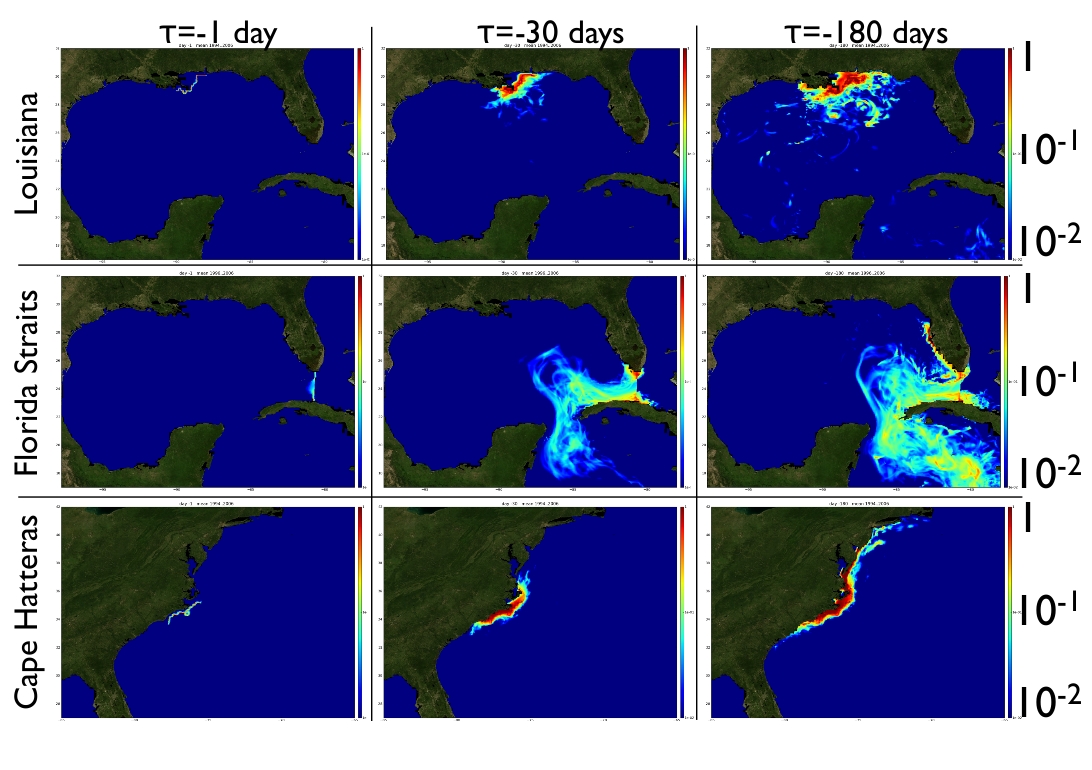Adjoint approaches to assessing sensitivity to buoyant surface plumes.
story by Helen Hill
Prompted by the recent spill in the Gulf of Mexico, Ross Tulloch, Chris Hill and Oliver Jahn have been using MITgcm to compute the vulnerability of individual locations to remote buoyant surface plumes.
Atmospheric studies have long used adjoint approaches to understand potential sources of pollutant plumes. In the context of spreading surface plumes, Tulloch et al. were interested in
- establishing techniques to identify ocean pollutant source regions that might impact a given location
The approaches they developed looked at different coastal points and gave a measure of what pollution event locations have a significant impact on a specific point.
Backwards Integration: Adjoint Sensitivity Experiment
With much of the US coastline newly approved for oil and gas exploration, the team wondered how useful their model could be in predicting vulnerable of different parts of the coastline to hypothetical spill events.
Linear advection of the tracer allowed the team to run its flow backwards in time to compute the source distributions that impact a particular region.
Assuming tracer in the forward model accumulates at the coastline at some rate:
Figure 1, below, shows the region of sensitivity for sections of coastline to spills 1, 30 and 180 days previously for coastal locations in Louisiana, in the Florida Straits and at Cape Hatteras.

Figure 1: Adjoint Sensitivity – Left to right, the ensemble mean fraction of tracer sensitivity at the “coastline” after 1, 30 and 180 days, for coastal regions (top to bottom) Louisiana, the Florida Straits and Cape Hatteras – source: R. Tulloch, C.N. Hill & O. Jahn
Model validation
To understand the robustness of these results the work included
- exploring the role of increased resolution of ocean eddies
- comparing inferences from particle based, lagrangian, approaches with eulerian, field based, approaches
- examining the impact of the differential response of oil particles and water to normal and extreme, hurricane derived, wind stress.
Using global circulation estimates for 1992-2007 from the ECCO2 project they examined the following questions
- Is the simulated response to a pollutant injection markedly different for different years, depending on ocean circulation and wind forcing?
- Does the simulated response depend heavily on resolution?
- Are lagrangian and eulerian estimates comparable?
Starting from two regional configurations at 16km and 4km resolutions respectively, both covering the Gulf of Mexico and western North Atlantic regions, the simulations were driven at open boundaries with momentum and hydrographic fields from ECCO2 observationally constrained global circulation estimates (fig.2). The time dependent surface flow fields from these simulations were used to transport a dye that could optionally decay over time (approximating biological breakdown) and to transport lagrangian particles. Floats were injected at a rate of 1 per hour from April 20, to July 15, 1995 (2088 floats per year). Using these experiments Tulloch and co. examined the robustness of conclusions regarding the fate of a buoyant slick, injected at a single point.

Figure 3: Float fraction beyond a particular radius (on day 40) (upper panel), Fraction of floats east of the Florida Straits (lower panel) – source: R. Tulloch, C.N. Hill & O. Jahn
Figure 3 shows the evolving eulerian tracer (left hand panel) after 6, 48, 90 and 132 days. The upper left hand plot shows the fraction of floats outside a given radius of the source site as a function of radius for each ensemble member after 40 days of integration. Beneath, is a figure graphing the fraction of floats East of the Florida Straits as a function of float age. The latter metric is associated with the state of the loop current. In some of the years none of the floats cross the Florida Straits in the first 100 days, in other years 50 percent of them do. The black line in each plot corresponds to the time mean for all experiments.
Dilution Factor

Figure 4: Arrival times of “dilution factor” – Ensemble mean arrival time in days (left-hand panels) and Fraction of ensemble members reaching a dilution factor of 0.01 after 190 days (right-hand panels), for bin-sizes 5km and 20km (upper and lower panels) – source: R. Tulloch, C.N. Hill & O. Jahn
The team measured the “dilution factor” defined by Maltrud et al in their 2010 paper, as the ratio of the amount of tracer in the water column to the amount injected at the source, as a dispersal metric.
Sensitivity to Resolution

Figure 5: The role of increased resolution: Ensemble mean arrival time in days (left-hand panels) and Fraction of ensemble members reaching a dilution factor of 0.01 after 190 days (right-hand panels), for bin-sizes 5km and 20km (upper and lower panels) – source: R. Tulloch, C.N. Hill & O. Jahn
The team found that while grid resolution did affect ensemble variance it had no effect on the ensemble mean. Figure 6 below shows how changed resolution altered plume dispersal characteristics. The top panel shows the float fraction east of Florida (= east of 81 W). To the left is the graph for the higher resolution case, in the middle is the same graph but for the lower resolution case. The graph on the right compares the float fraction East of Florida at 100 days as a function of time for the duration of the experiment, with the blue line corresponding to the higher resolution case. The bottom panel shows parallel plots but based on the float fraction beyond 200km at day 40.
There is more inter-annual variability in the 20km resolution ensemble (all or nothing stirring depending on the loop current), and the fraction east of Florida is not correlated with the 5km ensemble.
Effect of High Resolution Extreme Winds
The team found that embedding winds from the 2005 Hurricane season from H*WIND into the ECCO2 winds did not seem to make a significant difference to spill evolution. Figure 6, below, compares tracer distributions for late August 2005 conditions with the same fields from 1 month later, for high (6km) resolution H*WIND winds (top panels) and low (125km) resolution ECCO2 winds (bottom panels): there is little difference between the two scenarios.

Figure 7: Tracer distribution for late August 2005 (left) and 1 month later (right), for high-resolution winds (top panels) and low-resolution winds (bottom panels). Pressure field is contoured in white – source: R. Tulloch, C.N. Hill & O.Jahn
Future Work
Looking forward the team are interested in incorporating a more detailed coastline, as well as including tides and the wetting and drying of grid cells.
To find out more about this work contact Ross...

Ross has been using MITgcm since 2009. When he isn’t busy modeling the ocean he is currently in training for this year’s Boston Marathon.



